Software-defined data centers were originally met with suspicion. In fact, two years ago, “software-defined” anything was largely considered marketing hype. According to experts, only organizations with pre-existing homogeneous environments could take advantage of it. Times change. Today, the Software Defined Data Center (SDCC) is transforming the service provider (SP) industry.
March 18, 2016

Sponsored Content
 Software-defined data centers were originally met with suspicion. In fact, two years ago, “software-defined” anything was largely considered marketing hype. According to experts, only organizations with pre-existing homogeneous environments could take advantage of it. Times change. Today, the Software Defined Data Center (SDCC) is transforming the service provider (SP) industry.
Software-defined data centers were originally met with suspicion. In fact, two years ago, “software-defined” anything was largely considered marketing hype. According to experts, only organizations with pre-existing homogeneous environments could take advantage of it. Times change. Today, the Software Defined Data Center (SDCC) is transforming the service provider (SP) industry.
Nonetheless, service providers still face challenges, and these issues remain thorny:
Resource constraints: There are not enough qualified cloud professionals to meet demand for services. This talent shortage, along with the complexity of the technology, puts a crimp in the SP’s ability to provide customers with innovative solutions that effectively differentiate, compete, and attract new business.
Pricing pressures: IT has always been challenged to demonstrate ROI. Even organizations with aligned IT and business capabilities continue to look for ways to reduce data center costs.
Service Level Agreements: There is unrelenting pressure on solution providers to strengthen SLAs across the board—just to hold onto their existing customers. Seeing a way out of the conundrum can be difficult for SPs, and makes partnering with a vendor that provides the right technical solutions, training, and support critical to helping SPs expand opportunities.
How Leveraging Virtualization Across the Data Center Helps
SDDC addresses and alleviates many issues facing SPs. It begins with expanding virtualization across the data center, while providing a central 360-degree view of all software-defined operations.
VMware believes that leveraging virtualization in networking and storage maximizes operational efficiencies and provides flexibility to deliver high-value services at affordable costs. The key to achieving leverage is visibility, particularly in hybrid cloud implementations. Centralized management visibility is crucial because: Visibility = Control = Faster Problem Resolution
Finding the cause of cloud performance problems demands complex and expensive diagnostic tools and techniques. VMware’s SDDC management solution–vRealize Operations or vROPS–provides visibility across the compute, network and storage layers of the data center, allowing SPs to identify–and fix–problems faster.
Yves Sandfort, CEO of Comdivision, a VMware Enterprise Partner, puts it this way:
“We rely on VMware vRealize Operations because service providers need to operate their environment with more efficiency, and vROPS helps them do just that. The solution helps us ensure constant performance, while also giving our customers the ability to login and see the performance of the classroom environment. With vROPS they can view any delays or abnormal application behavior, just like they could in their own environment.”
Enabling Self Help
No two end users are exactly alike, and managing variations in cloud implementations across customers increases in complexity as SPs’ business growth further strains resources and SLAs. VMware’s SDDC strategy provides centralized visibility into customers’ cloud environment performance. VMware SPs can also provide functions, benefits and capabilities of the SDDC directly to customers and tenants, enabling them to proactively identify troubles before performance is negatively affected.
Optimize Workload Management–as a Team
As Gartner Research Director Mindy Cancila asserts, “management tools lag behind the maturity of the cloud services.” Providers offer tools that are proficient when managing their own platforms, but inept with a hybrid or multi-cloud environment. This is exactly the problem vROPS solves.
When SPs implement vROPS in the dedicated cloud environment and offer it to customers, they increase their capability to make strategic workload assessments and optimize on- and off-premise data centers. These balanced workloads and troubleshooting tools save money and help convince end-users to move additional workloads to service providers.
Which SPs Will Take the Lead?
Regardless of the pace of SDDC adoption, SPs currently partnered with the right vendor have the advantage into the future.
“vROPS is a powerful management tool for service providers of any size because it creates visibility into so many areas of your cloud environment, and this data enables greater transparency with customers, and, ultimately, their trust that you are doing what’s right for their business,” says Sandfort. “We can put a value on the efficiency gains from vROPS and the improvements in performance, but the added-value of achieving trusted advisor status with your customer is priceless.”
The Software-Defined Data Center has come a long way in the last couple of years, and is now perhaps the most efficient way for SPs to manage hybrid cloud environments in a truly unified fashion.
Curious? Find out more about how vROPs can help service providers generate new revenue in this video.
Ajay Patel is the senior vice president of the cloud provider software business unit at VMware.
You May Also Like
